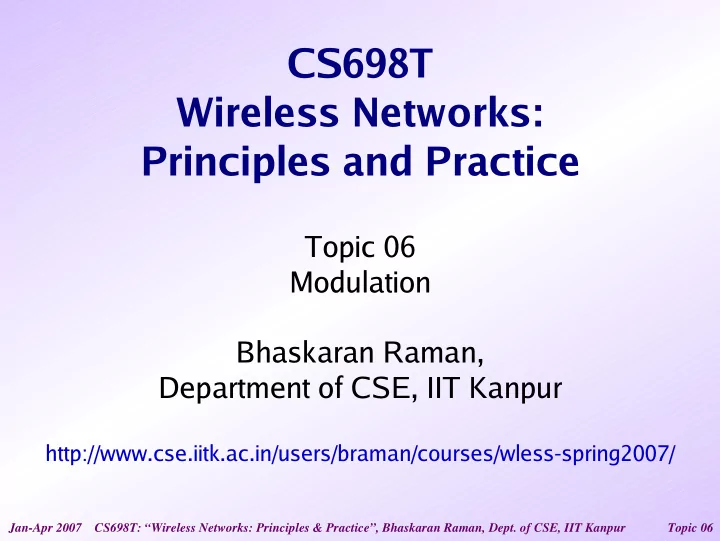

CS698T Wireless Networks: Principles and Practice Topic 06 Modulation Bhaskaran Raman, Department of CSE, IIT Kanpur http://www.cse.iitk.ac.in/users/braman/courses/wless-spring2007/ Jan-Apr 2007 CS698T: “Wireless Networks: Principles & Practice”, Bhaskaran Raman, Dept. of CSE, IIT Kanpur Topic 06
Modulation ● Modulation: the process of converting a digital signal to “ ap propriate” s ignals on wire or on air (wireless) ● Wireless: – Digital modulation: converting the digital signal to an analog signal – This results in a signal with bandwidth proportional to B Hz, if the digital signal is B bits/sec Jan-Apr 2007 CS698T: “Wireless Networks: Principles & Practice”, Bhaskaran Raman, Dept. of CSE, IIT Kanpur Topic 06
The Need for Analog Modulation ● Cannot send a signal of frequency B Hz directly: – Antenna size may be inappropriate – Propagation characteristics may not be desirable – Frequency Division Multiplexing (FDM) not possible ● Hence analog modulation: – Convert one frequency range to another – Using a carrier frequency Jan-Apr 2007 CS698T: “Wireless Networks: Principles & Practice”, Bhaskaran Raman, Dept. of CSE, IIT Kanpur Topic 06
Modulation at the Transmitter Source: Mobile Communications, Jochen Schiller Also known as keying Jan-Apr 2007 CS698T: “Wireless Networks: Principles & Practice”, Bhaskaran Raman, Dept. of CSE, IIT Kanpur Topic 06
Demodulation at the Receiver Source: Mobile Communications, Jochen Schiller Jan-Apr 2007 CS698T: “Wireless Networks: Principles & Practice”, Bhaskaran Raman, Dept. of CSE, IIT Kanpur Topic 06
An RF Signal g t = A t sin 2 ×× f t × t t ● Has three components: amplitude, frequency, and phase ● Modulation/keying can be based on any of these three (or a combination) Jan-Apr 2007 CS698T: “Wireless Networks: Principles & Practice”, Bhaskaran Raman, Dept. of CSE, IIT Kanpur Topic 06
Amplitude Shift Keying Source: Mobile Communications, Jochen Schiller Jan-Apr 2007 CS698T: “Wireless Networks: Principles & Practice”, Bhaskaran Raman, Dept. of CSE, IIT Kanpur Topic 06
Frequency Shift Keying Source: Mobile Communications, Jochen Schiller Jan-Apr 2007 CS698T: “Wireless Networks: Principles & Practice”, Bhaskaran Raman, Dept. of CSE, IIT Kanpur Topic 06
Phase Shift Keying Source: Mobile Communications, Jochen Schiller Jan-Apr 2007 CS698T: “Wireless Networks: Principles & Practice”, Bhaskaran Raman, Dept. of CSE, IIT Kanpur Topic 06
Some Remarks ● Phase Shift Keying: binary, quadrature, etc. – 802.11b uses BPSK, QPSK, CCK ● Metrics in modulation: – Spectral efficiency: bits/sec/hz – Power efficiency – Robustness to noise Jan-Apr 2007 CS698T: “Wireless Networks: Principles & Practice”, Bhaskaran Raman, Dept. of CSE, IIT Kanpur Topic 06
BER vs. SNR ● For a given modulation: – Bit-Error-Rate (BER) is a function of the Signal- to-Noise-Ratio (SNR) ● Thermal noise: k x T x B – k: Boltzmann’s constant = 1.38 x 10^-23 – T: temperature in Kelvin – B: bandwidth in Hz ● Strictly, Signal-to-Interference-and-Noise- Ratio (SINR) must be used Jan-Apr 2007 CS698T: “Wireless Networks: Principles & Practice”, Bhaskaran Raman, Dept. of CSE, IIT Kanpur Topic 06
Spread Spectrum Source: Mobile Communications, Jochen Schiller ● Spreading a signal over a wider frequency range – Avoids narrow-band interference – E.g. 802.11b Barker code: 10110111000 ● Two techniques for spread-spectrum – Direct Sequence, Frequency Hopping Jan-Apr 2007 CS698T: “Wireless Networks: Principles & Practice”, Bhaskaran Raman, Dept. of CSE, IIT Kanpur Topic 06
Recommend
More recommend